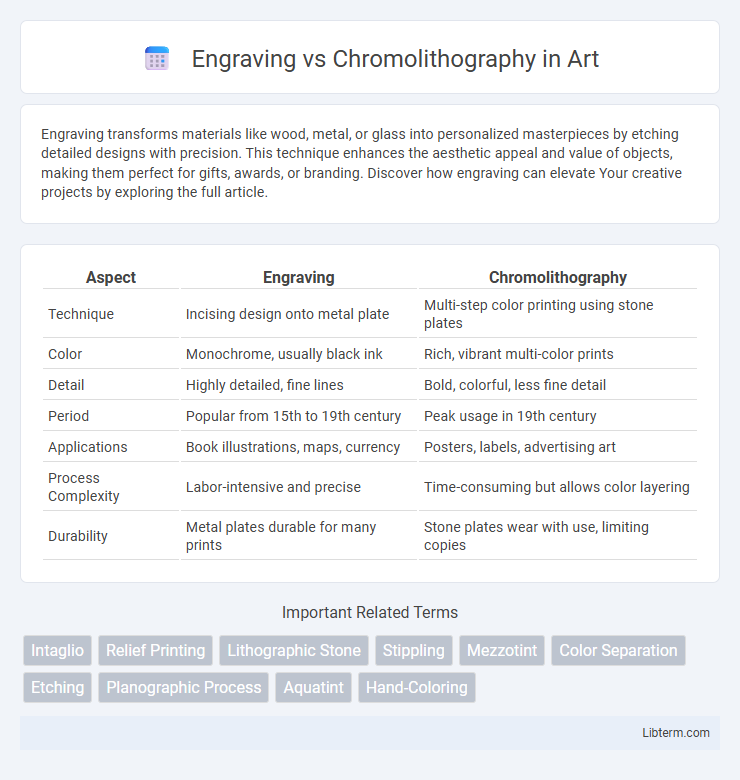Engraving transforms materials like wood, metal, or glass into personalized masterpieces by etching detailed designs with precision. This technique enhances the aesthetic appeal and value of objects, making them perfect for gifts, awards, or branding. Discover how engraving can elevate Your creative projects by exploring the full article.
Table of Comparison
| Aspect | Engraving | Chromolithography |
|---|---|---|
| Technique | Incising design onto metal plate | Multi-step color printing using stone plates |
| Color | Monochrome, usually black ink | Rich, vibrant multi-color prints |
| Detail | Highly detailed, fine lines | Bold, colorful, less fine detail |
| Period | Popular from 15th to 19th century | Peak usage in 19th century |
| Applications | Book illustrations, maps, currency | Posters, labels, advertising art |
| Process Complexity | Labor-intensive and precise | Time-consuming but allows color layering |
| Durability | Metal plates durable for many prints | Stone plates wear with use, limiting copies |
Introduction to Engraving and Chromolithography
Engraving involves incising a design onto a hard surface, typically metal, using a burin to create detailed and precise lines that hold ink for printing. Chromolithography uses multiple lithographic stones or plates, each inked with different colors, to produce vibrant, multi-colored prints through a chemical process on smooth limestone or metal surfaces. Both techniques revolutionized printing in the 19th century but differ significantly in method, texture, and color application, with engraving excelling in fine detail and chromolithography in rich, layered color.
Historical Evolution of Printing Techniques
Engraving, originating in the 15th century, revolutionized printing with its detailed, hand-carved metal plates producing fine lines and intricate images primarily for currency, maps, and artworks. Chromolithography emerged in the 19th century as a color printing technique using multiple stone plates, enabling vibrant, mass-produced prints that transformed advertising, posters, and commercial art. The transition from engraving to chromolithography marked a significant evolution from labor-intensive monochrome prints to efficient, colorful mass reproduction methods.
What Is Engraving?
Engraving is a traditional printmaking technique that involves incising a design onto a hard surface, typically a metal plate, using a burin or graver. This process creates grooves that hold ink, allowing for highly detailed and precise prints characterized by fine lines and rich textures. Renowned for its durability and ability to capture intricate artwork, engraving remains a valuable method in producing banknotes, certificates, and fine art prints.
The Process of Chromolithography Explained
Chromolithography is a vibrant printing technique that uses multiple layers of colored ink applied with stone or metal plates to create detailed images. Each color requires a separate plate, meticulously aligned through a process called registration, allowing for precise color blending and complex designs. This method revolutionized mass production in the 19th century by enabling high-quality, multi-colored prints that surpassed the monochromatic detail of traditional engraving.
Materials and Tools Used in Each Technique
Engraving employs metal plates, typically copper or steel, with sharp tools like burins to carve intricate designs directly into the surface, enabling high precision and detail. Chromolithography utilizes limestone or aluminum plates and greasy crayons or inks for drawing, relying on the chemical repulsion between oil and water to transfer vibrant colors layer by layer. The materials and tools in engraving allow for fine line work and texture, while chromolithography emphasizes color layering and mass production.
Artistic Applications and Styles
Engraving offers precise, intricate line work favored for detailed portraits and fine art prints, with its ability to render textures and shading through carefully carved plates lending a classic, timeless style. Chromolithography enables vibrant, multi-colored prints using layered stones or plates, making it ideal for decorative posters, advertisements, and botanical illustrations that demand rich color saturation and visual impact. Both techniques influence artistic applications differently: engraving emphasizes meticulous craftsmanship and monochromatic depth, while chromolithography celebrates bold color palettes and graphic vibrancy.
Print Quality and Visual Differences
Engraving produces prints with sharp, fine lines and intricate details due to its intaglio process, resulting in high-quality, tactile images with rich tonal variations. Chromolithography uses multiple color stones or plates to create vibrant, flat areas of color but often lacks the depth and precision found in engraved prints. Visually, engraving features crisp contours and subtle shading, while chromolithographs display bold, vivid colors with less textural detail.
Commercial and Industrial Uses
Engraving offers precise, high-quality detail ideal for printing currency, certificates, and luxury packaging, making it valuable in security printing and premium branding industries. Chromolithography, utilizing multiple color layers, excels in large-scale commercial printing such as posters, advertisements, and product labels where vibrant colors and mass production are essential. Both techniques serve distinct industrial purposes, with engraving favored for fine detail and anti-counterfeiting measures, while chromolithography dominates in colorful, high-volume commercial displays.
Advantages and Limitations
Engraving offers high precision and durability, producing fine details ideal for banknotes and fine art prints, but it is labor-intensive and costly. Chromolithography enables vibrant color reproduction suitable for posters and commercial printing but may lack the sharpness and longevity of engraved works. Engraving's tactile texture contrasts with chromolithography's smooth surface finish, influencing selection based on artwork purpose and budget.
Choosing the Right Technique for Your Project
Choosing between engraving and chromolithography depends largely on your project's detail and color requirements; engraving offers precise, intricate line work ideal for high-definition monochrome images, while chromolithography excels in producing vibrant, multi-colored prints with rich texture. Consider the project's scale and budget, as engraving is typically more time-consuming and costly but yields lasting, fine detail, whereas chromolithography suits larger editions with complex color layering at a lower cost per unit. Evaluating the intended visual impact and reproduction volume ensures selecting the technique that best aligns with your artistic goals and production constraints.
Engraving Infographic

 libterm.com
libterm.com